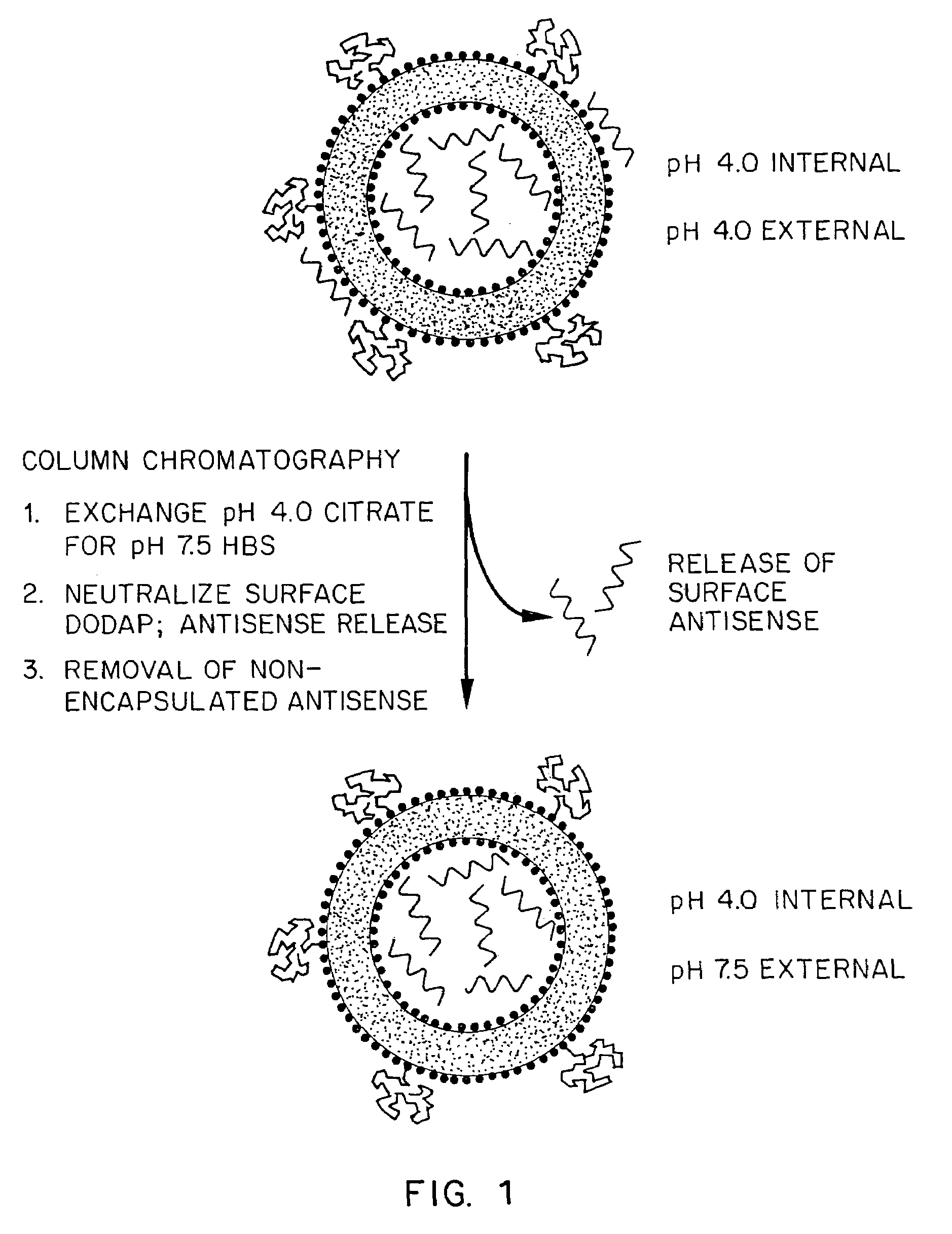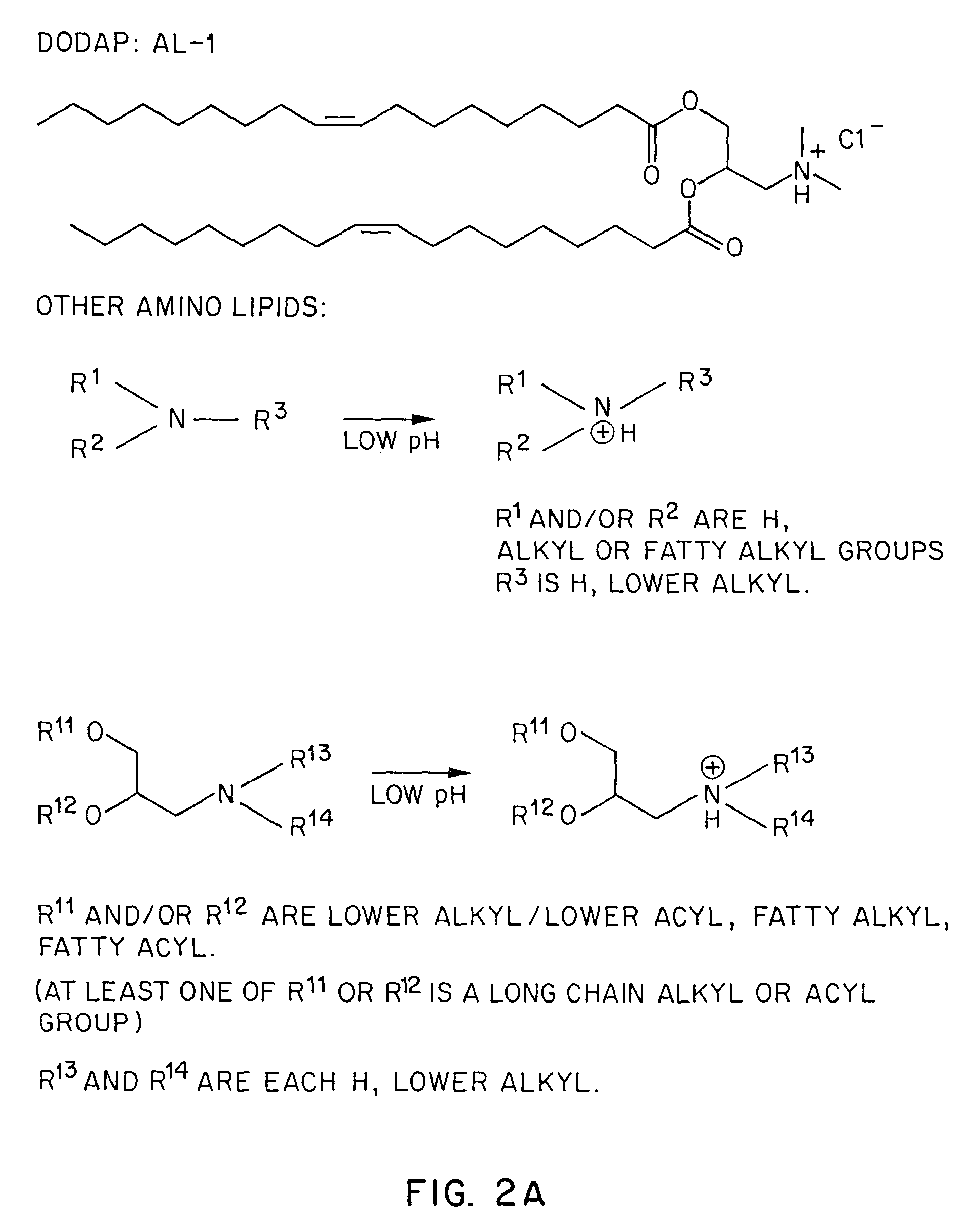Lipid-encapsulated polyanionic nucleic acid
a polyanionic nucleic acid and lipid technology, applied in the direction of dna/rna fragmentation, oil/fat/waxes non-active ingredients, immobilised enzymes, etc., can solve the problem of short half-life in the presence of serum or within cells, no clinical assessment currently employs the basic phosphodiester chemistry, and none of these solutions have proved entirely satisfactory
- Summary
- Abstract
- Description
- Claims
- Application Information
AI Technical Summary
Benefits of technology
Problems solved by technology
Method used
Image
Examples
example 1
[0141]This example illustrates the effects of ethanol on the encapsulation of antisense.
[0142]A 20mer of [3H]-phosphorothioate antisense oligodeoxynucleotide (in 300 mM citrate buffer, pH 3.80) was mixed with an ethanol solution of lipid (DSPC:CHOL:DODAP:PEG-CerC14; 25:45:20:10, molar ratio) at final concentrations of 2 mg / mL and 9.9 mg / mL, respectively. The final ethanol concentration in the preparations was varied between 0 and 60%, vol / vol. The samples were extruded ten times through three 100 in filters as described in “Materials and Methods”. The samples were dialyzed for 2-3 hours in 300 mM citrate buffer, pH 3.80, to remove a majority of the excess ethanol. The samples were switched to HEPES-buffered saline (HBS), pH 7.50, and dialyzed for a minimum of 12 hours to replace the external citrate buffer with HBS. This renders the majority of DODAP in the outer bilayer neutral, and will release any surface bound antisense. Non-encapsulated antisense was then removed from the lipos...
example 2
[0145]This example illustrates the effects of DODAP on the encapsulation of antisense, and further illustrates the effect of initial antisense concentration on the compositions.
[0146]Having demonstrated that ethanol can greatly facilitate the preparation of lipid vesicles containing entrapped antisense, the next step was to examine the influence of DODAP (AL-1) content on the encapsulation of antisense (FIG. 5). Accordingly, a 0.6 mL aliquot of a [3H]-phosphorothioate antisense oligodeoxynucleotide (in 300 mM citrate buffer, pH 3.80) was mixed with 0.4 mL of a 95% ethanol solution of lipid (DSPC:CHOL:DODAP:PEG-CerC14; 100-(55+X):45:X:10, molar ratio) at final concentrations of 2 mg / mL and 9.9 mg / mL, respectively. The molar ratio of DODAP was varied between 0 and 30%. The molar ratio of DSPC was adjusted to compensate for the changes in DODAP content. The samples were extruded ten times through three 100 nm filters as described in “Materials and Methods”, and were dialyzed for 2-3 ho...
example 3
[0149]This example illustrates the properties of the liposomal antisense formulations provided in the Materials and Methods above.
[0150]The size distribution of a liposomal preparation of antisense was determined by quasi-elastic light scattering (QELS) immediately after removal of the free antisense (A), and after storage of the preparation for 2 months at 4° C. (B), using a Nicomp Model 370 sub-micron particle sizer. A 0.6 mL aliquot of a [3H]-phosphorothioate antisense oligodeoxynucleotide (in 300 mM citrate buffer, pH 3.80) was mixed with 0.4 mL of a 95% ethanol solution of lipid (DSPC:CHOL:DODAP:PEG-CerC14; 25:45:20:10, molar ratio) at final concentrations of 2 mg / mL and 9.9 mg / mL, respectively. The sample was extruded ten times through three 100 nm filters as described in “Materials and Methods”, and dialyzed for 2-3 hours in 300 mM citrate buffer, pH 3.80, to remove a majority of the excess ethanol. The sample was switched to HEPES-buffered saline (HBS), pH 7.50, and dialyzed...
PUM
| Property | Measurement | Unit |
|---|---|---|
| size | aaaaa | aaaaa |
| concentrations | aaaaa | aaaaa |
| concentrations | aaaaa | aaaaa |
Abstract
Description
Claims
Application Information
 Login to View More
Login to View More - R&D
- Intellectual Property
- Life Sciences
- Materials
- Tech Scout
- Unparalleled Data Quality
- Higher Quality Content
- 60% Fewer Hallucinations
Browse by: Latest US Patents, China's latest patents, Technical Efficacy Thesaurus, Application Domain, Technology Topic, Popular Technical Reports.
© 2025 PatSnap. All rights reserved.Legal|Privacy policy|Modern Slavery Act Transparency Statement|Sitemap|About US| Contact US: help@patsnap.com



